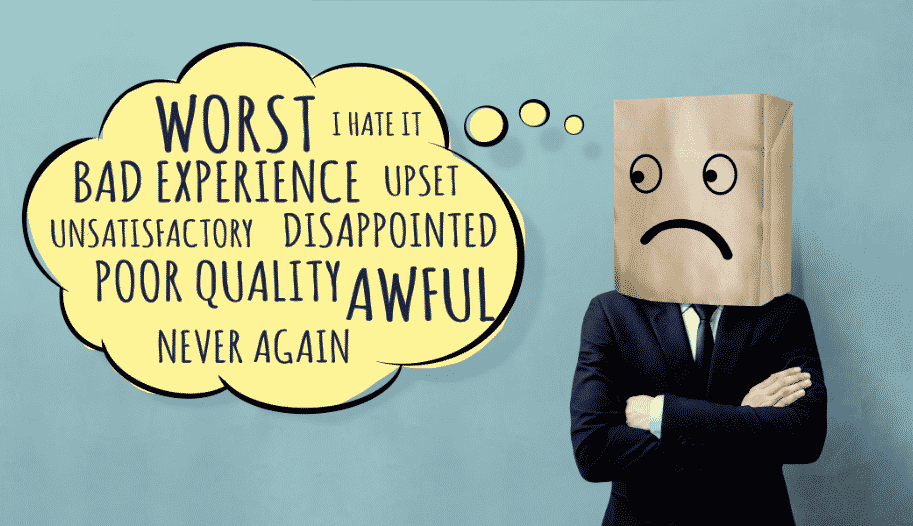With more and more people shopping online, this year has meant a slew of returned products, damaged goods, and unhappy customers.
Sometimes, these outcomes are simply out of your control. But at other times, maybe something really did go wrong on your end — and that’s okay. It’s important to be honest with your customers, and when it comes to online feedback, this task can be very daunting.
In an age of online reviews and screenshot conversations, you can never be too careful. While we understand that your business is important to you, and it feels good to defend it — especially when a customer is out of line — sometimes it’s better to choose your battles.
Save that energy for your next big idea or for rewarding your best customers and VIPS. Establish a clear plan for handling unhappy customers and be done with it!
Define “Flagged” Reviews
If you’re the sole manager, business owner, and employee at your business, it can be hard to set protocol for yourself. Even with a small staff, many owners don’t get around to defining procedures for internal operations, so it can be difficult to know when a response is out of line.
Try to take a second to figure out any language, situations, or problems that could lead your team to “flag” a review. When these expectations are in place, it’ll be easier to identify a starting point and make sure no hurtful comments go unnoticed.
This is especially important with a larger team because your employees may sometimes end up dealing with the backlash before you. If this is the case, you want to have procedures in place, so your team knows how to handle the situation — and avoids “customizing” their response.
No matter how close you are with your employees, it will be a huge headache if you have to deal with a ton of bad press or an ugly tweet storm spurred by one snarky comment.
Set Expectations For Responses
The most important thing you can try to do in a difficult situation is empathize. When that customer is coming at you with a ton of bad energy, this can seem impossible and, if anything, extremely unfair. Rest assured that you’re probably right, and this energy is likely coming from another aggressor and, unfortunately, being taken out on you.
Take a deep breath and think about everything you love about your business, then put yourself in your customer’s shoes. Try to examine your business from their point of view and in terms of their review. Were there steps in the process that was out of your control? Did they order take-out, only to receive a cold meal because they lived too far away? Did their dry cleaning get crinkled in the delivery process — or did they not realize they were allergic to a product you use?
Examine your business in terms of the steps it takes for a customer to secure your product or service. Try to imagine what could go wrong in each step and how you would address the situation.
If you plan out these ideas ahead of time, you’ll have a bank to draw from in the heat of the moment and be able to maneuver the situation more easily. Moreover, if you create this resource for your employees, they’ll better handle the stress of the situation and have a better understanding of how to respond.
Using Digital Tools to Identify Complaints
There are so many platforms out there today it would be nearly impossible to keep up with all of them.
Instead, many businesses rely on digital tools to keep up with the bad press for them. Especially because customers may not even complain directly on your website or Yelp, it’s important to have a system in place to search for keywords like your business name and “disappoint,” “bad,” or “never.”
While it may be painful to take this step, you’ll be glad you went ahead and anticipated the worst when it happens. With tools like HootSuite, you can keep track of all your social media platforms in one place and be sure to catch any flagged comments.
Other programs like PipeDrive allow you to take it one step further and monitor websites beyond your own platforms. This program is an important PR tool that allows businesses of all sizes to keep up with their customer relationships.
Because it integrates into Google (like a plug-in or app that you can embed in your search bar), it can monitor those same keywords or phrases on a larger scale. If it sounds intimidating, don’t worry. It’s designed to be super user-friendly, so small businesses can use it at their own pace — and it’s certainly easier than reading through thousands of webpages every day.
Create Good Press in Your Community
When you’re first starting, it’s important to advertise your business in your community to make sure you set the tone. Branding yourself as a small, local business is a great way to get customers excited about your services and allows you to form a soft spot for your brand. A super-easy way to do this is to look into grocery store advertising. Grocery store advertising allows for hyper-local targeting because most grocery stores pull customers in from a three-mile radius of the store. That means a ton of local press on your supermarket advertisement and thousands of daily impressions.
Programs like coupon-receipt advertising allow you to send your supermarket advertisement home in the pocket of every single shopper. At the same time, Cartvertising is a way to post your own mini billboard on shopping carts around the store.
Either option leaves plenty of room for customization and can be tailored to your small business’s needs. There’s nothing consumers equate with their community more than their local grocery store, so if you’re looking to build a positive brand in your small town, this can be a great starting place.


 By IndoorMedia Marketing
By IndoorMedia Marketing
